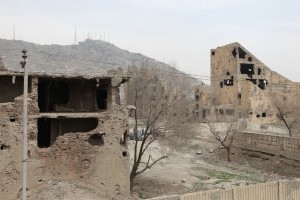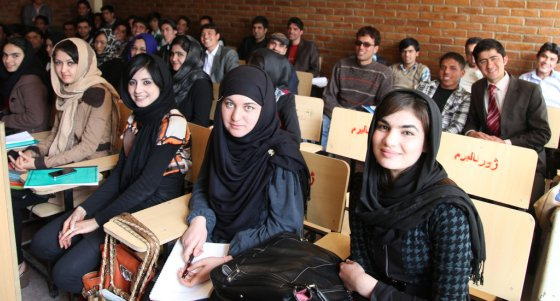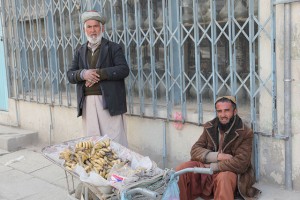
Suicide bombings forced Guerrazzi to cut short a previous trip, and people advised her to cancel this trip as well (Guerrazzi image).
By Diane Guerrazzi, Assistant Professor of Journalism and Mass Communications
(Editor’s Note: Professor Guerrazzi sent the following from Afghanistan, where she is helping establish college journalism programs. Her work is funded by the U.S. State Department.)
As I was guest lecturing to a journalism class of 30 students at Kabul University today, a student wearing a Western-professional grey blazer in the back row stood up. He thanked me for coming to Afghanistan, in spite of the danger, and said it proved to him that Americans really do care. Until I heard that young man, I had underestimated the impact of this trip.
With raw feelings over the shooting of innocent civilians in Kandahar, many people advised me to cancel the trip. I traveled here twice last year, and the coordinated suicide bombings forced me to return to San Jose early. However, it’s clear to me now that this new trip is well timed. We cannot erase the damage and suffering, but we can show our support and prove to the people here that we follow through with our promises.
This was planned as a partnership-building trip to meet the journalism faculty at Balkh University in the north, near Mazar-i-Sharif. The SJSU School of Journalism and Mass Communications this February received $1 million from the U.S. State Department to help modernize the journalism program at Balkh. It’s the second $1 million grant that my colleague Peter Young and I co-wrote; the first was with Herat University in Western Afghanistan. I am heading to Balkh and Herat next week, but this initial stop in the capital city is equally as important.
Kabul University is considered the “mother ship” of all public universities in Afghanistan. Decisions made in this senior institution ripple through the system. I sat down with a dozen journalism professors here, hearing their hopes for improvement and their frustrations over having so little to work with. For example, the professors have no projectors in their classes. That means no Power Point or video examples. The students have no computers or cameras to work with.
That means they “learn” about journalism — heavy on the theory — without putting their hands on the tools of the trade. A media center has been built to provide a working television studio, but for now it’s just a shell of the building. Technology is on the way, but for now it’s still just a promise.
After spending the morning at Kabul University, I went with journalism professor Jawida Ahmadi to Suboot News Agency, a 15-minute drive. Ahmadi founded the agency, whose motto is: “An effort to reflect truths.” In addition to a print edition, Suboot publishes on the Web.
Over a lunch of fried eggs, potatoes and yoghurt, Ahmadi said she’s especially interested in training female journalists; she began teaching young girls how to report in the Taliban era. For now, Ahmadi runs Suboot with money from the U.S. Embassy, Kabul, the same provider of the SJSU-Balkh-Herat grants. If Subhoot funding runs dry, Ahmadi does not know how she will afford rent or electricity, but she is determined to continue shaping young journalists.
We at SJSU are devoting most of our grant toward training the Herat and Balkh professors, the vast majority of whom have nothing above a bachelor’s degree. We are also arranging internships for students to gain hands-on experience in Balkh and Herat. This trip to Afghanistan will likely be my last. The rest of the training will take place on safer ground; we will meet the Afghans in Dubai for a summer Journalism Academy the next three years. We will also host the professors at SJSU for eight weeks this fall and next spring. We’ll expose them to our student media, including the Spartan Daily, Access and Shift Magazines, Update News and Equal Time. We hope they will come away as true partners, not only as journalists, but as friends who keep their promises.




